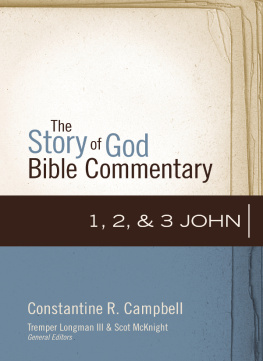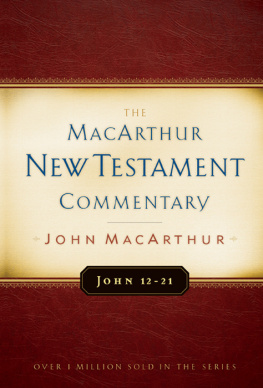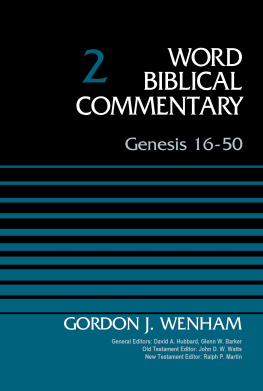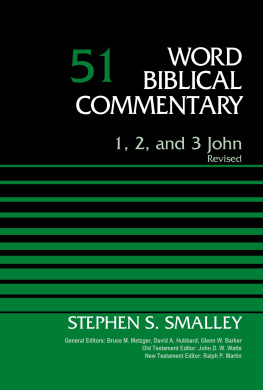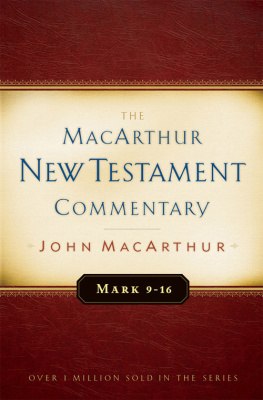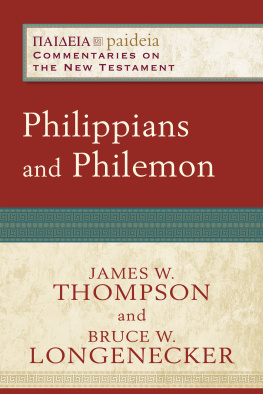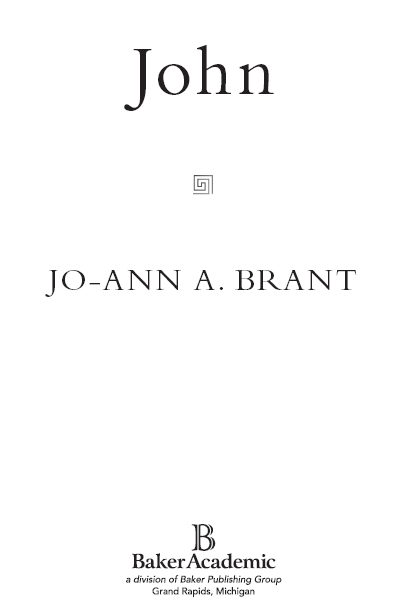
2011 by Jo-Ann A. Brant
Published by Baker Academic
a division of Baker Publishing Group
P.O. Box 6287, Grand Rapids, MI 495166287
www.bakeracademic.com
Ebook edition created 2012
All rights reserved. No part of this publication may be reproduced, stored in a retrieval system, or transmitted in any form or by any meansfor example, electronic, photocopy, recordingwithout the prior written permission of the publisher. The only exception is brief quotations in printed reviews.
ISBN 978-1-4412-3563-3
Library of Congress Cataloging-in-Publication Data is on file at the Library of Congress, Washington, DC.
Unless otherwise indicated, all quotations from the Gospel of John and the rest of the New Testament are the authors own translation. Quotations from the Hebrew Bible are from the New Revised Standard Version of the Bible, copyright 1989, by the Division of Christian Education of the National Council of the Churches of Christ in the United States of America. Used by permission. All rights reserved.
Jo-Ann Brant is attentive to both the background and the reception history of the Gospel. She first traces the narrative flow of each section of the Gospel and then explores some of the theological issues that emerge from it. Drawing on everything from Greco-Roman rhetoric to Shakespeare to modern American pop culture, Brant offers fresh perspectives on specific points in virtually every chapter, provides a coherent picture of the Gospel as a whole, and identifies resources for the reader to explore further. By any measure, a significant and welcome contribution.
J. Ramsey Michaels, professor of religious studies emeritus,
Missouri State University
Brant skillfully mines the Greco-Roman literary, rhetorical, and social world of the Fourth Gospel and writes with brevity that moves the reader briskly along from one fresh insight to the next. The result is paideia a wonderfully formative experience!
R. Alan Culpepper, dean, McAfee School of Theology,
Mercer University
This marvelous commentary is packed with substantive information and fresh insights. Brant draws on current literary approaches and an array of useful sources from antiquity to illumine Johns Gospel. She likewise makes the complexities of the Greek text intelligible for English readers. One may disagree with interpretations at points, but I find them consistently stimulating and well thought out. As with other volumes in the Paideia series, this one is masterfully designed to provide optimum access for readers.
Craig S. Keener, professor of New Testament,
Asbury Theological Seminary
Among the spate of commentaries published on Johns Gospel, Brants is distinctive and distinguished. Informed by Greco-Roman rhetoric and sources, archaeology, maps, and arresting sidebars, the commentary excels for the classroom. It may well become the text of choice for the university classroom and will enhance appreciation of the Bible as literature. The author and publisher merit commendation, especially for the layout and the inclusion of many illustrative figures that catch the eye and tables that facilitate grasp of content.
Willard Swartley, professor emeritus of New Testament,
Associated Mennonite Biblical Seminary
Jo-Ann Brant has written a commentary that thoughtfully leads the reader deeply into the Gospel of John as well as the Greco-Roman world that shaped it. Students who read carefully will be rewarded with not only a profoundly enriched understanding of the Gospel but also a solid introduction to Greco-Roman literary, rhetorical, and dramatic traditions.
Colleen M. Conway, professor of religious studies,
Seton Hall University
Jo-Ann Brant has written a commentary on the Fourth Gospel that is ideal for the classroom and the pastors study, while also proving useful to the scholar. She serves as an authoritative guide to the world of ancient literature and makes two major contributions. First, by paying close attention to the intricacies of the Johannine narrative, she demonstrates in considerable detail the sophistication with which the Fourth Gospel was constructed. Second, she gives attention to both the Jewish and Hellenistic backgrounds of the Fourth Gospel without overemphasizing one at the expense of the other. I recommend this commentary highly.
Chris Keith, assistant professor of New Testament and
Christian origins, Lincoln Christian University
Brant engages extensively with both ancient and modern sources in such a way that the student receives an introduction to major figures and currents in both the ancient world and modern scholarship on John. Her special focus on ancient rhetoric includes explanation of the terms and techniques, providing the student with a lively working introduction to this field of study. Her commentary is clear, concise, and engaging, with many insights that provide an important supplement to the more conventional and comprehensive commentaries.
Rodney A. Whitacre, professor of biblical studies,
Trinity School for Ministry

G ENERAL E DITORS
Mikeal C. Parsons and Charles H. Talbert
A DVISORY B OARD
Paul J. Achtemeier
Loveday Alexander
C. Clifton Black
Susan R. Garrett
Francis J. Moloney
Contents

Figures and Tables

Figures
Tables
Foreword

Paideia: Commentaries on the New Testament is a series that sets out to comment on the final form of the New Testament text in a way that pays due attention both to the cultural, literary, and theological settings in which the text took form and to the interests of the contemporary readers to whom the commentaries are addressed. This series is aimed squarely at studentsincluding MA students in religious and theological studies programs, seminarians, and upper-division undergraduateswho have theological interests in the biblical text. Thus, the didactic aim of the series is to enable students to understand each book of the New Testament as a literary whole rooted in a particular ancient setting and related to its context within the New Testament.
The name Paideia (Greek for education) reflects (1) the instructional aim of the seriesgiving contemporary students a basic grounding in academic New Testament studies by guiding their engagement with New Testament texts; (2) the fact that the New Testament texts as literary unities are shaped by the educational categories and ideas (rhetorical, narratological, etc.) of their ancient writers and readers; and (3) the pedagogical aims of the texts themselvestheir central aim being not simply to impart information but to form the theological convictions and moral habits of their readers.
Each commentary deals with the text in terms of larger rhetorical units; these are not verse-by-verse commentaries. This series thus stands within the stream of recent commentaries that attend to the final form of the text. Such reader-centered literary approaches are inherently more accessible to liberal arts students without extensive linguistic and historical-critical preparation than older exegetical approaches, but within the reader-centered world the sanest practitioners have paid careful attention to the extratext of the original readers, including not only these readers knowledge of the geography, history, and other contextual elements reflected in the text but also their ability to respond correctly to the literary and rhetorical conventions used in the text. Paideia commentaries pay deliberate attention to this extratextual repertoire in order to highlight the ways in which the text is designed to persuade and move its readers. Each rhetorical unit is explored from three angles: (1) introductory matters; (2) tracing the train of thought or narrative or rhetorical flow of the argument; and (3) theological issues raised by the text that are of interest to the contemporary Christian. Thus, the primary focus remains on the text and not its historical context or its interpretation in the secondary literature.
Next page

